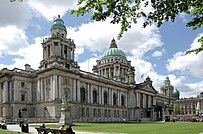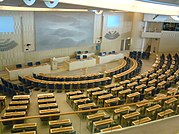Tionól
This article is incomplete because it is pending further input from participants, or it is a work-in-progress by one author. Please comment on this article's talk page to share your input, comments and questions. Note: To contribute to this article, you may need to seek help from the author(s) of this page. |
Tionól of Caldia | |
|---|---|
| 33rd Legislature | |
 | |
| Type | |
| Type | |
| Leadership | |
| Structure | |
| Seats | 399 |
 | |
Political groups | Government (218)
Opposition (181)
|
Length of term | 5 years |
| Elections | |
| Mixed-member proportional representation (MMP) | |
Last election | 18 February 2019 |
Next election | 12 June 2022 |
| Meeting place | |
 | |
| Meeting Chamber Carrowdun Palace, Spálgleann | |
| Website | |
| tionól.gl | |
The Tionól of Caldia, often simply the Tionól, is the supreme legislative body in Caldia. It alone possesses legislative supremacy and thereby ultimate power over all other political bodies in Caldia. Its head is the Monarch of Caldia (currently King Kenneth IV) and its seat is Carrowdun Palace in Spálgleann.
The legislature is bicameral, consisting of an upper house (the Seanad Glítteann) and a lower house (the Comhthionól Náisiúnta). The monarch forms the third component of the legislature (the King-in-Tionól).
In 1814, the Seanad was established by the Constitution of Caldia and the first democratic national elections were held in the country that same year. The Comhthionól was created following the Silent Revolution through the Instrument for Governance Act of 1857.
Name
The name Tionól literally means meeting in Ghaillish. It can also be translated as assembly. Tionól was derived from the name of the bodies that advised the High Chiefs of the petty kingdoms that existed before the unification of Caldia
History
Powers and structure
Composition
The Tionól has 399 members. A member of the legislature is legally known as a Teachta Tionól (TT) which literally means a Deputy of the Meeting. Operationally, a member is referred to as Teachta Comhthionól (TC) or a Deputy of the Assembly. This is what members of the now defunct Comhthionól Náisiúnta were known as. Since the Comhthionól effectively became the unicameral Tionól, the old title remains widely used in official parliamentary and other sources.
Membership of the Tionól is open to Caldish citizens who are 18 or older. To become a member, an individual must be a Caldish citizens, an EC citizen residing in Caldia, or a legally registered resident of Caldia.
Of the chambers 399 members, a majority (213 or 53.4%) are women. Caldia is among the nations with the highest proportion of females in a national legislature and is one of the few with a majority of the chamber being female. 45 (11.3%) of the chamber's members are from an ethnic minority or foreign background.
Members of the Tionól are full-time legislators. They receive a salary of €6250 per month, or €75,000 annually. Many of the chamber's members maintain a residence in Spálgleann on either a part-time or full-time basis. Members who are elected to represent constituencies are required to live in their constituency, however many also have an additional residence in the capital.
Parties
| Party | Leaders | Seats | Seat share (%) | |
|---|---|---|---|---|
| Social Democratic Party (PSD) | Stiofán Mac Suibhne | 218 | 54.64 | |
| Liberty Party (S) | Pádraig Mac Piarais | 89 | 22.31 | |
| National Party (PN) | Liam Ó Cuillinn | 57 | 14.29 | |
| Centre Party (PM) | Lachlann Mac an Fhleisteir | 12 | 3.00 | |
| Democratic Left (DC) | Seán Ó Caoláin | 8 | 2.01 | |
| The Greens (G) | Colm Ó Corráin Ciara Nic Innes |
6 | 1.50 | |
| Caldish Democrats (DG) | Muirís Ó Branagáin | 5 | 1.25 | |
| Homeland (M/TD) | Einion ap Calder | 1 | 0.25 | |
| Pensioners' Party (PP) | Ellie Níc Raghnaill | 1 | 0.25 | |
| Independent | 2 | 0.5 | ||
| Total | 399 | 100 | ||
Elections
Members are directly elected at least once every five years by the electorate of Caldia under a mixed-member proportional representation system. Its 399 seats were divided into 200 multi-member constituencies and 199 seats that were allocated based on a party's vote share using an open list. Parties are required to pass a threshold of 2.5% to qualify to win list seats. There are XX multi-member constituencies. Each consistency has between three and five members.A version of single-transferable vote known as the Ní Dochartaigh method is used for the constituencies. Under this process, voters rank candidates by first and second preference. Unlike other methods of single transferable vote, they can only rank candidates in this order and cannot transfer their vote to more than one additional candidate. This is similar to the contingent vote system, but members are not required to be elected with a majority as they stand in multi-member constituencies.
Members are directly elected at least once every five years by the electorate of Caldia under a mixed-member proportional representation system. Its 399 seats were divided into 200 multi-member constituencies and 199 seats that were allocated based on a party's vote share using an open list. Parties are required to pass a threshold of 2.5% to qualify to win list seats. There are XX multi-member constituencies. Each consistency has between three and five members.A version of single-transferable vote known as the Ní Dochartaigh method is used for the constituencies. Under this process, voters rank candidates by first and second preference. Unlike other methods of single transferable vote, they can only rank candidates in this order and cannot transfer their vote to more than one additional candidate. This is similar to the contingent vote system, but members are not required to be elected with a majority as they stand in multi-member constituencies.
The last election was held on 18 February 2019. The next regularly scheduled election will be held on 12 June 2022.
2019 election results
| File:Comhthionól Composition.png | ||||||
|---|---|---|---|---|---|---|
| Party | Votes | % | Seats | +/– | ||
| Social Democrats (PSD) | 3,140,869 | 48.8 | 218 | +101 | ||
| Liberty Party (S) | 1,184,262 | 18.4 | 89 | -67 | ||
| National Party (PN) | 875,324 | 13.6 | 57 | +34 | ||
| Centre (PL) | 258,092 | 4 | 12 | -21 | ||
| Labour Party (PLO) | 199,522 | 3.1 | 8 | -20 | ||
| The Greens (G) | 193,086 | 3 | 6 | –5 | ||
| Caldish Democrats (D) | 161,549 | 2.5 | 5 | -13 | ||
| Caldish Independence Party (PNG) | 147,389 | 2.3 | 0 | –6 | ||
| Pensioners' Party (PP) | 75,304 | 1.2 | 1 | – | ||
| Homeland (M/TD) | 12,916 | .2 | 1 | +1 | ||
| Forward (Y/AA) | 10,942 | .2 | 0 | -1 | ||
| Other parties | 95,256 | 1.48 | 0 | - | ||
| Independents | 81,740 | 1.3 | 2 | +2 | ||
| Invalid/blank votes | 37,801 | – | – | – | ||
| Total | 6,474,052 | 100 | 399 | 0 | ||
| Registered voters/turnout | 7,347,270 | 87.6 | – | – | ||
Sessions
In a normal legislative year, there are two legislative sessions. The first session marks the return of the legislature from the Nativity and Winter Recesses. The monarch presides over the official State Opening of the Tionól on the he first Monday following the Epiphany holiday. The State Opening starts with a procession down the Royal Mile starting from Clochnoc Fortress and terminates at Carrowdun Palace. It also sees a speech from the throne made by the monarch, which outlines the government's agenda for the first session. Both chambers are present for the official opening of the first legislative session. The first session ends in July with the Summer Recess. The Tionól reconvenes on the third Sunday of August for the start of the second session, which ends with the close of the legislature for that legislative year on the third Sunday of December. The close is presided over by the monarch.
In a legislative year with a general election, there are three legislative sessions. Instead of ending in July, the first session ends when the Comhthionól is dissolved by the monarch on 12 May, a month before the election is set to take place, following the issuing of the writ of elections. A care-taker government led by the current government is then in place until the Comhthionól reconvenes on the first Monday following the election. However, it cannot reconvene unless a government can be formed, meaning the recess may last longer than the first Monday. The second session then lasts from June to July and the third from August to December. The Seanad always goes into recess at the same time as the Comhthionól
The Tionól is generally in session Monday to Thursday. However, it will meet on Friday's when there is legislation the Government or the Ceann Comhairle designates as urgent. Many TCs take advantage of the lack of regular Friday sessions and opt to return to their constituencies for the weekend to handle local matters. Recesses, however, officially declare the Tionól closed on designated Fridays. This means that the presiding officer in either chamber cannot call the chamber back for an emergency session. However, the monarch is able to issue a writ of return. Cabinet meetings take place on Monday mornings, meaning Cabinet ministers are absent from the Comhthionól. This time is traditionally reserved by the introduction of private member's bills. On Wednesday's at noon, the Taoiseach holds a session of Taoiseach's Questions. Party leaders and backbenchers are invited to ask him or her questions about the government's agenda for the legislative session. Four cabinet member's also usually make themselves available for questioning after the Taoiseach is finished.
Unlike the Comhthionól, the Seanad only sits on Fridays. However, the Cathaoirleach can summon senators for a special session on any day of the week the Tionól is not in recess. A weeks notice must be given before the Seanad can convene for a special session. During a Seanad election year, the chamber is dissolved on the second Monday of May by the monarch and reconvenes on the first Monday after the election.
Recesses
During the the 2020 calendar year, the Tionól is scheduled to be in recess a total of nine times.
In an election year, the legislature enters a General Election Recess from 12 May to the first Monday after the 12 June election. It goes into recces following the following the dissolution of the Comhthionól Náisiúnta on 12 May.
| Name | Dates | Notes |
|---|---|---|
| Winter Recess | 1 January - 7 January | Is an extension of the Nativity Recess. |
| Liberation Day Holiday Recess | 12 February | The public holiday for Liberation day was observed on Monday 12 February. |
| Easter Recess | 6 April - 13 April | The recess is in accordance with the Easter Holiday and moves on a yearly basis. |
| Beltane Holiday Recess | 1 May | |
| National Day Holiday Recess | 20 May | |
| Summer Recess | 1 July - 17 August | |
| St. Ellen's Day Holiday Recess | 7 September - 11 September | |
| October Recess | 5 October - 9 October | |
| Nativity Recess | 14 December - 31 December |

